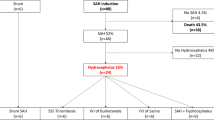Abstract
Purpose
Previous animal models of obstructive hydrocephalus that was frequently combined with subarachnoid inflammation are not suitable for investigating cerebrospinal fluid (CSF) flow between ventricles and cisterns in obstructive hydrocephalus. In this study, we attempted to develop a new animal model for obstructive hydrocephalus in rats sparing subarachnoid space using N-butyl cyanoacrylate (NBCA).
Methods
Hydrocephalus was induced in adult male Sprague–Dawley rats with NBCA (n = 15) or with kaolin (n = 10). For the NBCA model, a silicone tube was inserted through the foramen of Magendie into the fourth ventricle, into which 20 μL of a mixture of NBCA and ethiodized oil was injected. For the kaolin model, 100 μL of 20% kaolin solution was injected into the cistern magna. The rats in the NBCA and kaolin groups were sacrificed 3 and 21 days after surgery, respectively.
Results
Eleven rats in the NBCA group developed hydrocephalus (73.3%), with a 13.3% mortality rate. The kaolin group showed hydrocephalus in eight rats (80%), with a 20% mortality rate. The mean Evans’ indices were 0.37 ± 0.02, 0.45 ± 0.04, and 0.53 ± 0.09 in the control, NBCA, and kaolin groups, respectively (p < 0.05). There was no remarkable arachnoid adhesion or inflammatory change of the ventricular wall in the NBCA group.
Conclusions
The NBCA model seems to be a useful animal model for acute obstructive hydrocephalus with preserved subarachnoid CSF pathway. This model can be useful for studying CSF flow between ventricles and cisterns.






Similar content being viewed by others
References
Abdullah A, Sachithanandan S, Tan OK, Chan YM, Khoo D, Mohamed Zawawi F, Omar H, Tan SS, Oemar H (2009) Cerebral embolism following N-butyl-2-cyanoacrylate injection for esophageal postbanding ulcer bleed: a case report. Hepatol Int 3:504-508
Bering EA Jr, Sato O (1963) Hydrocephalus: changes in formation and absorption of cerebrospinal fluid within the cerebral ventricles. J Neurosurg 20:1050–1063
Brothers MF, Kaufmann JC, Fox AJ, Deveikis JP (1989) n-Butyl 2-cyanoacrylate—substitute for IBCA in interventional neuroradiology: histopathologic and polymerization time studies. AJNR Am J Neuroradiol 10:777–786
Cai X, McGraw G, Pattisapu JV, von Kalm L, Willingham S, Socci D, Gibson JS (2000) Hydrocephalus in the H-Tx rat: a monogenic disease? Exp Neurol 163:131–135
D’Amato CJ, O’Shea KS, Hicks SP, Glover RA, Annesley TM (1986) Genetic prenatal aqueductal stenosis with hydrocephalus in rat. J Neuropathol Exp Neurol 45:665–682
Del Bigio MR (2000) Calcium-mediated proteolytic damage in white matter of hydrocephalic rats? J Neuropathol Exp Neurol 59:946–954
Diggs J, Price AC, Burt AM, Flor WJ, McKanna JA, Novak GR, James AE Jr (1986) Early changes in experimental hydrocephalus. Invest Radiol 21:118–121
Drake JM, Potts DG, Lemaire C (1989) Magnetic resonance imaging of silastic-induced canine hydrocephalus. Surg Neurol 31:28–40
Hochwald GM, Lux WE Jr, Sahar A, Ransohoff J (1972) Experimental hydrocephalus. Changes in cerebrospinal fluid dynamics as a function of time. Arch Neurol 26:120–129
Hochwald GM (1985) Animal models of hydrocephalus: recent developments. Proc Soc Exp Biol Med 178:1–11
Ishizaki R, Tashiro Y, Inomoto T, Hashimoto N (2000) Acute and subacute hydrocephalus in a rat neonatal model: correlation with functional injury of neurotransmitter systems. Pediatr Neurosurg 33:298–305
Johanson C, Del Bigio M, Kinsman S, Miyan J, Pattisapu J, Robinson M, Jones HC (2001) New models for analysing hydrocephalus and disorders of CSF volume transmission. Br J Neurosurg 15:281–283
Johnson MJ, Ayzman I, Wood AS, Tkach JA, Klauschie J, Skarupa DJ, McAllister JP, Luciano MG (1999) Development and characterization of an adult model of obstructive hydrocephalus. J Neurosci Methods 91:55–65
Kim DS, Oi S, Hidaka M, Sato O, Choi JU (1999) A new experimental model of obstructive hydrocephalus in the rat: the micro-balloon technique. Childs Nerv Syst 15:250–255
Klarica M, Oreskovic D, Bozic B, Vukic M, Butkovic V, Bulat M (2009) New experimental model of acute aqueductal blockage in cats: effects on cerebrospinal fluid pressure and the size of brain ventricles. Neuroscience 158:1397–1405
Krishnamurthy S, Li J, Schultz L, McAllister JP 2nd (2009) Intraventricular infusion of hyperosmolar dextran induces hydrocephalus: a novel animal model of hydrocephalus. Cerebrospinal Fluid Res 6:16
Lodhia KR, Shakui P, Keep RF (2006) Hydrocephalus in a rat model of intraventricular hemorrhage. Acta Neurochir Suppl 96:207–211
Milhorat TH (1970) Experimental hydrocephalus. 1. A technique for producing obstructive hydrocephalus in the monkey. J Neurosurg 32:385–389
Odake G, Yamaki T, Naruse S (1978) CSF-circulation pathways in experimental hydrocephalus of the rat (author’s transl). Neurol Med Chir Tokyo 18:673–680
Penn RD, Lee MC, Linninger AA, Miesel K, Lu SN, Stylos L (2005) Pressure gradients in the brain in an experimental model of hydrocephalus. J Neurosurg 102:1069–1075
Ransohoff J, Shulman K, Fishman RA (1960) Hydrocephalus: a review of etiology and treatment. J Pediatr 56:399–411
Shapiro K, Kohn IJ, Takei F, Zee C (1987) Progressive ventricular enlargement in cats in the absence of transmantle pressure gradients. J Neurosurg 67:88–92
Slobodian I, Krassioukov-Enns D, Del Bigio MR (2007) Protein and synthetic polymer injection for induction of obstructive hydrocephalus in rats. Cerebrospinal Fluid Res 4:9
Stephensen H, Tisell M, Wikkelso C (2002) There is no transmantle pressure gradient in communicating or noncommunicating hydrocephalus. Neurosurgery 50:763–771, discussion 771–763
Vetsika EK, Bannister CM, Buckle AM, Miyan JA (1999) The effects of CSF blockage in early-onset hydrocephalus on the activity of the germinal epithelium. Eur J Pediatr Surg 9(Suppl 1):43–44
Vullo T, Manzo R, Gomez DG, Deck MD, Cahill PT (1998) A canine model of acute hydrocephalus with MR correlation. AJNR Am J Neuroradiol 19:1123–1125
Acknowledgements
This work was supported by the National Research Foundation of Korea (NRF) grant funded by the Korea government (MEST) (No. 20100026410).
Author information
Authors and Affiliations
Corresponding author
Rights and permissions
About this article
Cite this article
Park, Y.S., Park, S.W., Suk, J.S. et al. Development of an acute obstructive hydrocephalus model in rats using N-butyl cyanoacrylate. Childs Nerv Syst 27, 903–910 (2011). https://doi.org/10.1007/s00381-011-1398-9
Received:
Accepted:
Published:
Issue Date:
DOI: https://doi.org/10.1007/s00381-011-1398-9




